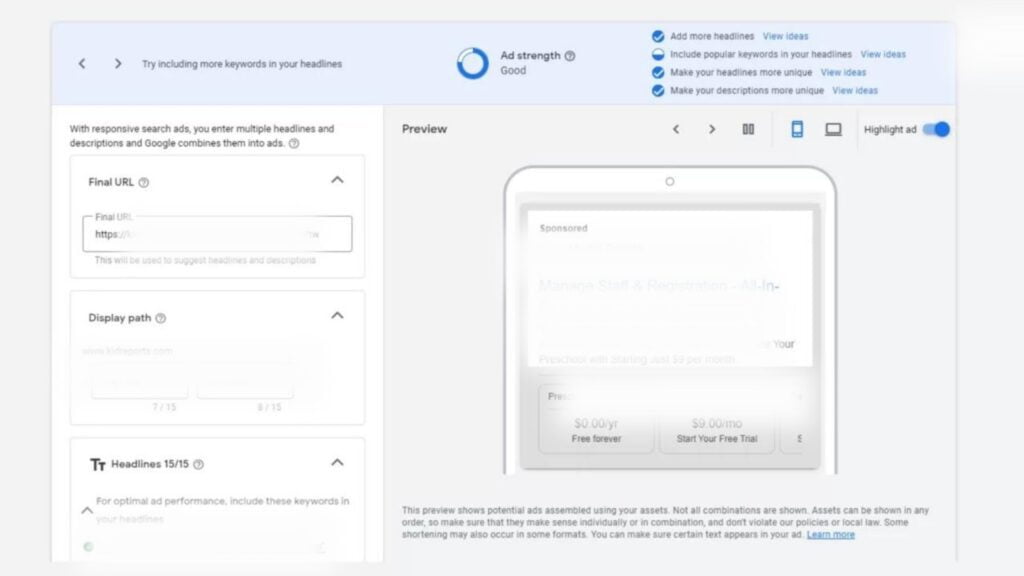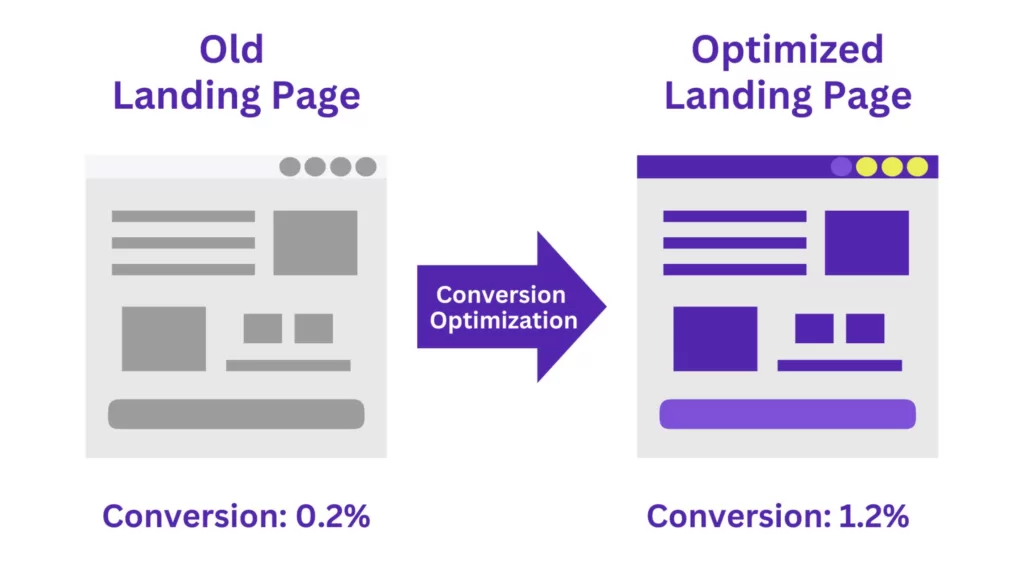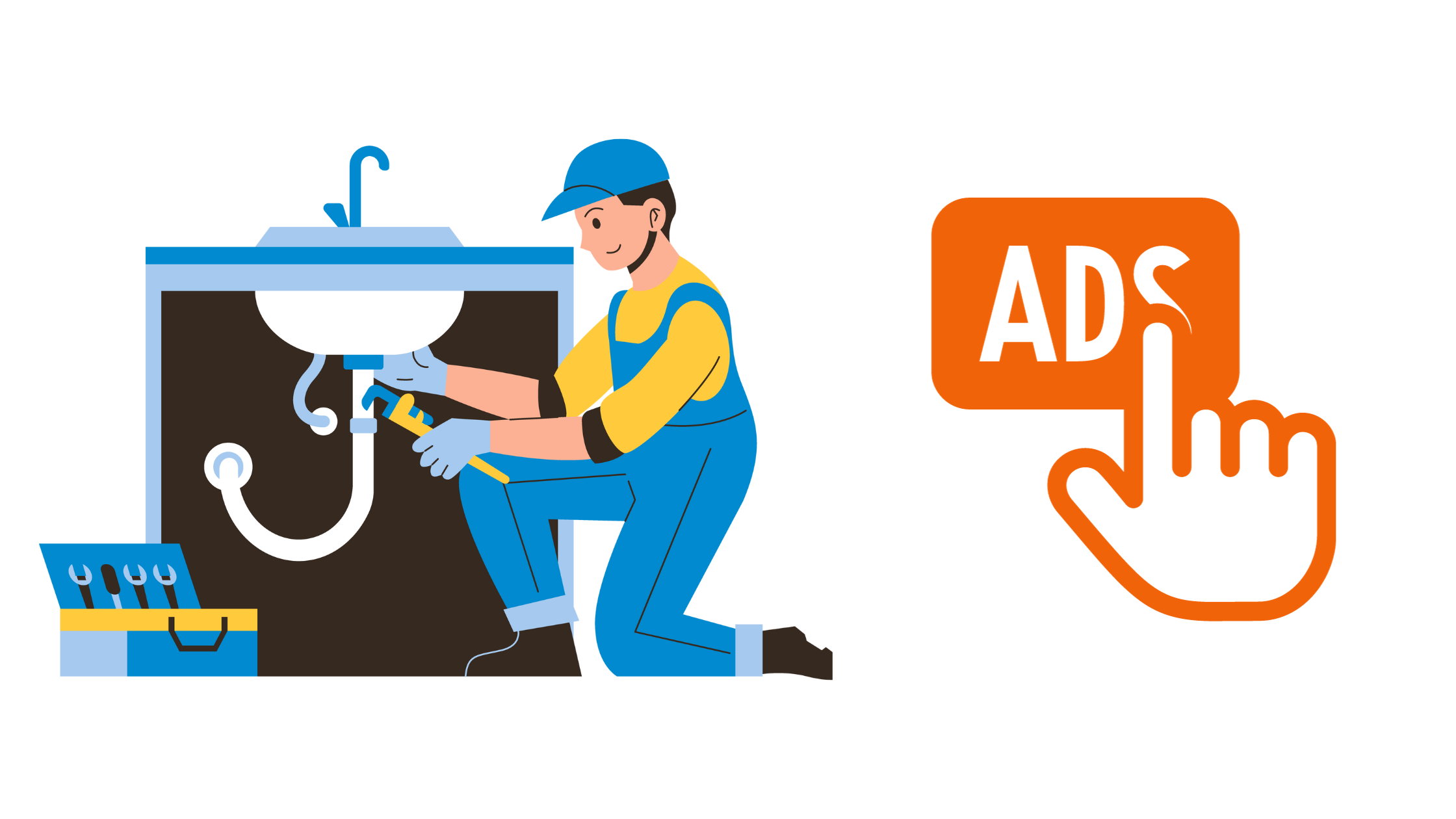People use Google to find answers to their problems. That’s why digital marketing is all about being there when consumers are looking for information about your plumbing business.
So, let’s start by understanding what Google Ads for plumbers is all about. One of its essential purposes is to give potential customers the information they need when they search for things related to your plumbing business. Of course, the ultimate goal is to get more leads for your company.
This guide will walk you through the steps to set up, analyze, and maintain your Google Ads for plumbing services. It’s all about making it easier for folks to find you when they need your expertise.
- What is Google Ads?
- How do Google Ads Modals Work?
- How Can Google Ads Benefit Your Plumbing Business?
- Things to Do Before Setting Up a Google Ads Campaign
- Overview of Creating a Google Ads Campaign for Plumbers
- The Ad Group Structure Includes:
- Tips and Optimization for Your Google Ads Campaign for Plumbers
- Additional Factors to Optimize
What is Google Ads?
Google Ads, previously known as Google AdWords, is Google’s pay-per-click (PPC) advertising platform. With Google Ads, you can connect with potential customers on Google Search and the Google Display Network.
Now, let’s break down what PPC, or Pay-Per-Click, means. It’s an online advertising model where advertisers only pay when someone clicks on their ad. Google Ads is a widely used platform that operates on this PPC system. But it’s important to note that many other online advertising platforms follow the same approach.
How do Google Ads Modals Work?
Google Ads operates on a unique auction model.

Each advertiser can submit their maximum bid for a click on a specific keyword. Google then uses a sophisticated algorithm, considering various factors, such as the bid amount and relevance, to determine the ranking of each advertiser’s ad.
How Can Google Ads Benefit Your Plumbing Business?

Here are some of the benefits of Google Ads for plumbing agencies:
Targeted Reach: Google Ads lets plumbing agencies reach customers actively searching for services. You show up when they need you most.
Cost Control: You set the budget and only pay when someone clicks your ad. No surprise costs, and you can adjust as needed.
Quick Results: Unlike SEO, Google Ads provides instant visibility. Your ad can be up and running within hours.
Local Targeting: Reach potential customers in your service area. No need to spend on areas you don’t serve.
Measurable Impact: Track performance with metrics like clicks, impressions, and conversions. Understand what works and refine your strategy.
Competitive Edge: Beat competitors to the punch. If they’re not using Google Ads, you have an advantage in capturing leads.
Things to Do Before Setting Up a Google Ads Campaign

Budget and Goals: Determine your ad budget and what you want to achieve, like more calls or website visits.
Account Structure: Organize your Google Ads account with well-defined campaigns and ad groups aligned with your plumbing services.
Choose Target Location: Plan where your ads appear. Pick by city, state, zip, or radius. Avoid wasting money where you can’t serve.
Create a Great Landing Page: Pay attention to it! Even with perfect keywords, a lousy landing page could save money. Make it keyword-relevant and sales-friendly for better results.
Start with Keywords: Choose relevant keywords, such as “plumber near me” or “emergency plumbing.” to target potential customers.
Conversion Tracking: Implement tracking to measure the success of your ads in terms of calls, inquiries, or other desired actions. It helps you gauge campaign performance.
Overview of Creating a Google Ads Campaign for Plumbers
1. Creating an Account
Creating a Google Ads account is straightforward. Start by clicking “Start Now” on the upper right-hand or left main page, using a fictitious plumbing company as an example. Sign in with your Gmail account.

Google will ask about your main advertising goal. Choose an option; for instance, “Get more website sales or sign-ups.” Scroll down and click “Switch to Expert Mode.”
Set campaign goals for customer conversions. Click “Create a campaign without a goal’s guidance” for more control. Select “Search” as your campaign type and choose “Website visits” and “Phone calls” as your desired results. This sets the stage for your plumbing business’s Google Ads journey.
A. Configuring General Settings
When setting up your campaign, start by naming it, like “Plumbing.” Consider deselecting the “Display Network” because it might not be the most cost-effective choice for many local plumbing businesses. It can lead to unnecessary spending as ads reach a wider audience without specific plumbing-related intent.

Alternatively, you can opt for the “Search Network” option, which lets your ads appear on Google’s network partners, such as Yelp, Ask, DuckDuckGo, and others. Remember, Google won’t disclose the sites where your ads will show. This suits businesses with a larger Google Ads budget. And remember, you can always tweak these settings as your campaign evolves.
B. Targeting and Audience
In the targeting and audience settings, ensure your location is set to your company’s base, like the United States in my case. For languages, select those spoken by your target customers; Google usually defaults to English, but includes other relevant languages if needed.

In the audience settings, opt for “Observation” and add audiences through the search tab. For this demo campaign, I chose a few plumbing-related audiences, but feel free to add more as per your needs. Remember, you can adjust these choices anytime later.
C. Setting Your Budget
In Google Ads, stick to a daily budget; weekly or monthly options aren’t available. When budgeting, play it safe; overspending happens fast, so optimize wisely.
Keep in mind that your daily budget should represent the maximum you are comfortable spending on the campaign.
For this demo, I’ll set the daily budget to $60.
Now, in the Bidding section, focus on Clicks for this campaign. For other campaigns, you can switch things up. Look for the “Set a maximum cost per click bid limit” box and check it. This way, you’ll have more say in how your daily budget is used. If you skip this step, Google takes the wheel, and your budget allocation might need to align with your goals.
D. Ad Extensions
In the ad extensions section, you can include your website link, callouts, your plumbing company’s phone number, and other useful extensions. Note that these extensions can also be configured at the ad group level, so you can choose to skip this step if you prefer.

2. Ad Groups

Now, let’s tackle ad group creation. Ad groups are where you group similar ads with common themes. When a user’s search matches your ad group’s keywords, your ad can appear on Google Search and, when clicked, take them to your landing page.
Keep in mind that ad groups work together to achieve your campaign goals. So, when crafting your ads, remember this synergy.
To start, consider structuring ad groups around sections of your website.
For instance, if your campaign centers on “plumbing services,” create ad groups for specific services like “drain cleaning” and “repiping.”
When setting up ad groups, Google will prompt you to add keywords for your ad targeting. You can use Google’s keyword tool for suggestions and customize the list. Significantly, you can adjust your keyword selection at any point during your campaign.
A. Creating Ad Groups
The Ad Group Structure Includes:

Final & Display URLs
The Final URL is where users land. Always use “HTTPS://” to avoid warnings. For example, if the ads about drain cleaning link to your drain cleaning services page. Users can explore your offerings there.
The Display URL shown in the ad should be concise and related. “www.greenplumber/drain-cleaning” works well, matching the ad content and directing users to the right page.
Headlines
Google suggests at least three headlines, each with a 30-character limit. Maximize this space; rephrase and adjust to fit. Use keywords and emphasize what makes your plumbing company unique. For example, highlight same-day services or competitive pricing.
Additionally, using upper and lower case letters for headlines is recommended.
Descriptions
Include at least two descriptions that convey your plumbing services’ authenticity and credibility. Mention customer count or years of experience to showcase reliability and success. These elements help users quickly gauge your business’s trustworthiness.
After adding your billing information, you’re ready to launch your ad.
3. Measuring Conversions
Once your ad has been running for a while, tracking its performance is essential. Measurement platforms help you assess various metrics, including clicks, impressions, Click-Through Rates (CTR), Conversion Per Clicks (CPC), and Total Revenue. These insights guide your campaign’s effectiveness.

A. +Conversion Tracking
Go to the top bar, click on “Tools & Settings,” then select “Conversions,” followed by “+Conversions.”
On the next page, specify the type of conversions you want to track and choose “Website.”
When evaluating conversions, remember your campaign goal. If, for example, your goal is to generate more leads, opt for “Request Quote” in the conversions category.
In the Value section, you can assign a consistent value to each conversion and adjust it according to your business.
For the Count section, select “One” and then click “Create and Continue.”
The next page prompts you to set up your conversion tag. Choose “Use Google Tag Manager,” click “Next,” and then “Done.”
Now, you’ll have a table displaying your configured conversions.
Tips and Optimization for Your Google Ads Campaign for Plumbers
1. Use Negative Keywords: Exclude irrelevant search terms from your campaign to save money and improve ad targeting.
2. “Be” Local: Emphasize your local presence in ad copy and keywords to attract nearby customers.
3. Use Geo-targeting: Narrow your ad reach to specific locations where your plumbing services are available.
4. Track Phone Call Leads: Monitor and analyze calls generated by your ads to gauge their effectiveness.
5. Focus on Relevant Keywords: Opt for keywords closely related to plumbing services to attract the right audience.
6. Build a Dedicated PPC Landing Page: Create a specific page on your website for ad clicks, providing tailored information for potential customers.
7. Add Ad Extensions: Enhance your ads with extensions like location information or call buttons for better visibility.
8. Test Ad Copies: Experiment with different ad variations to find what resonates best with your audience and boosts click-through rates.
Additional Factors to Optimize
Using Keyword Notes
You can edit or add keywords to your campaign anytime from your home page.
Scroll down to the “Summary” of your keywords, then click “Keywords,” followed by the “+” sign. This opens Google’s keyword generator for adding keywords.

Exact Match
Exact match keywords ensure your ad displays only when a user types your set keywords exactly. Use brackets to indicate an exact match.
For example:
- Exact Match: [drain cleaning service]
User Search Term: drain cleaning service In this case, your plumbing ad appears because the user’s search perfectly matches your keyword.
Negative Keywords
Negative keywords help control when your ads don’t appear for specific words or phrases. It’s a money-saving strategy to attract potential customers. Indicate negative keywords by adding a minus sign before them.
For example:
- Negative: -Drain Cleaning Facebook
This prevents your ad from showing when users search for drain cleaning on Facebook, as they’re likely not looking for a professional plumber.
Optimize your Landing Pages
Landing pages are a critical element in the journey of turning clicks into valuable customers. Users who click on your ad have specific expectations, and your landing page must meet those expectations to prevent them from leaving.

Here are some essential steps to optimize your landing pages for your plumbing website effectively:
Relevance is Key:
- Ensure your landing page closely aligns with the ad and keywords that brought the user there. If your ad promotes “discount plumbing services,” the landing page should prominently feature information about those discounted services.
- Mirror the call-to-action from your ad text on your landing page. If your ad encourages users to “schedule a plumbing consultation,” make it easy to find a scheduling form or contact information on the landing page.
- The connection between your ad and landing page should be seamless, as this directly impacts your chances of converting a visitor into a customer.
Mobile-Friendly Design:
- Recognize that many of your website visitors will be using mobile devices. Ensure your landing page is mobile-friendly, meaning it displays and functions correctly on smartphones and tablets.
- Page speed is crucial on mobile devices. Small-loading pages can deter potential customers. Optimize your site’s performance for mobile users to provide a seamless experience.
Ease of Navigation:
- Simplify the navigation on your landing page. Make it clear and straightforward for customers to perform the desired action, whether requesting plumbing services, contacting your team, or submitting an inquiry.
- Avoid clutter, excessive ads, or pop-ups that distract or frustrate visitors. A clean and organized layout enhances user experience.
Content is King:
- Provide informative and original content on your landing page that directly relates to the plumbing services you’re advertising. Explain what sets your plumbing company apart and how your services can benefit potential customers.
- Incorporate genuine customer reviews and testimonials to build trust and credibility. Genuine feedback from satisfied clients can influence decision-making positively.
Concise and Clear Messaging:
- Keep your messaging concise and clear. Avoid using marketing buzzwords or jargon that might confuse visitors. Speak directly to your audience in a conversational tone.
- Important information, such as your contact details, services offered, and unique selling propositions, should be prominently displayed at the top of the landing page for easy access.
Optimizing your plumbing website’s landing pages is essential for converting visitors into satisfied customers. By ensuring relevance, mobile-friendliness, easy navigation, informative content, and clear messaging, you create a user-friendly experience that encourages potential clients to take action. A well-optimized landing page can be a powerful tool in your digital marketing strategy for plumbers, helping your plumbing business thrive in the competitive online landscape.
An excellent example of a landing page meets these criteria.
FAQ’s
What are Google Ads for Plumbers?
Google Ads is an advertising platform where plumbers can create and display ads on Google’s search results. It helps them reach potential customers when they search for plumbing services online.
What is the Best Advertising for Plumbers?
The best advertising for plumbers often includes a mix of strategies. Google Ads is effective for online visibility, but local SEO, social media, and word-of-mouth referrals also play a significant role.
Does Google Ads Work for Plumbers?
Yes, Google Ads can work well for plumbers. It allows them to target specific keywords, locations, and demographics, helping them connect with customers actively searching for plumbing services.
How to Get More Plumbing Leads?
To get more plumbing leads, consider using online advertising like Google Ads, optimizing your website for local SEO, offering promotions, and asking satisfied customers for referrals. Building a strong online presence can also attract leads organically.




